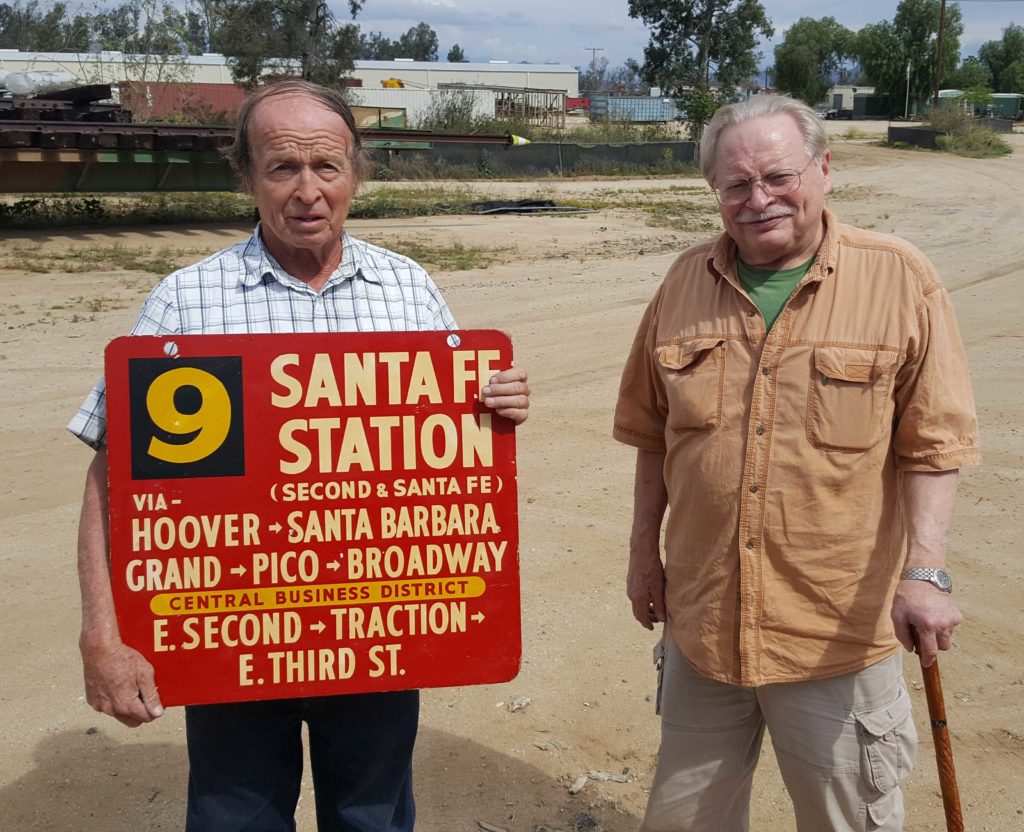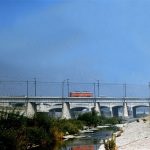LARy 893 and 1436: A Smash Hit on Broadway! (UPDATED)
see below for update!
By Ralph Cantos
For the most part, both the Pacific Electric and Los Angeles Railway were very safe rail systems. The PE operated at much higher speeds than the LARY, and as a result, produced some very spectacular accidents. The majority of the accidents on the PE occurred at grade crossings where just about every class of PE rail car, from the Echo Park 100s, PCCs, Hollywood cars, on up to the Blimps, were constantly challenged at grade crossings with automobiles driven by, for the most part, MORONS!
More often than not, the results were catastrophic damage to the automobile (and sometimes to its driver. as well). The PE car usually made it home under its own power to Torrance Shops for some brief R&R and a quick return to service. Other collisions that involved two or more PE rail cars were usually more dramatic and necessitated longer says at Torrance Shops.
The LARY, on the other hand, was a system where speeds rarely exceeded 40 mph. As a result, accidents were not as spectacular. Nonetheless, the LARY accident record could and did produce some amazing results.
Such an “incident” occurred one rainy night at the intersection of 2nd Street and Broadway during World War II. In this case, 9 Line car no. 893 was turning from westbound 2nd Street to southbound Broadway. For what ever reason, 5 Line car no. 1436 slid into the right side of the 893 amidships as the 893 was completing its left-hand turn. It was a rainy night, and with the exception of the PCCs, no LARY cars were equipped with windshield wipers (something that LATL management rectified on all H- and K-class cars after 1946).
One can only speculate that as the 1436 headed south on Broadway, its motorman cranking away on the Johnson Fare box, and the front windows blurred with rain, he did not see the red STOP sign displayed by the ACME traffic signal and ran into the side of 893 with the results depicted in this photo. Notice that the lights in the 893 ore still on, while the 1436 is dark.
Because of World War II passenger demands, every car was needed. Both cars were quickly returned to service.
The most noteworthy item in this photo is the front dash sign on the 893: it displays the entire route of the 9 Line as operated at that time. It reads: 9 West 48th St (48th & Crenshaw) via E. Third St-Traction- E. Second-Broadway (Central Business District) Pico-Grand Ave.-Santa Barbara and Hoover. According to LA traction historian and “dash sign GURU” Craig Rasmussen, if one of these dash signs still exists, and could be found, it would be the “HOLY GRAIL” of LARY dash signs. For now, all we can do is look at this photo and hope that one of these dash signs could still turn up at a traction swap meet. Do you have one in your collection??
Ralph Cantos Collection
April 12, 2016 Update!
By Terry Salmans
After reading Ralph Cantos’ article “LARy 893 and 1436: A Smash Hit on Broadway” I called fellow Orange Empire Railway Museum archivist Pat Ellyson to see if he had seen one of the “Holy Grail” LARy 9 Line dash signs in the OERM collection. He replied that he hadn’t but he had one in his own collection!
We arranged to meet up with another OERM archivist, Craig Rasmussen, for a photo op. Pat recalled that he had bought the dash sign years ago at a swap meet but couldn’t recall from whom.
According to Pat, in November 1936 these dash signs were introduced for the 9 Line. On September 24, 1939 the 9 Line was rerouted and the dash sign in the photo wasn’t used after that.
I’ve always wondered what a holy grail looked like. Now I know.
Terry Salmans Photo/Collection
-
[…] On the subject of the very rare 9 line dash sign, here is Los Angeles Railway no. 881 sporting the very same colorful dash sign. The 881 awaits departure time in front of the old Santa Fe Railway station on Santa Fe Ave at 2nd Street. This image is from around 1938. […]
Leave a Comment






Hi,
The wooden set on 1436 indicates that it has not been converted to one-man operation. Hence, the motorman may have been asleep-at-the-switch but he was’n cranking the farebox.
About 30+ years ago, I had one of these signs. They were red background with white lettering on one side and the reverse order of stations on the other with a green background. The line number was white on a black square. They were silk screened on Masonite board and had large brass grommets at the top to hang from the car front.
It came to me in great shape, except that it was used to stack green and red 5 gallon paint cans atop one another for stability and had “bucket rings” of paint on both sides.
It took about a week of using several packages of 0000 steel wool and about a dozen cans of lighter fluid to slowly get the enamel paid off without destroying the underlying letters. Almost like removing an oil painting that was painted over a better artists’ work, just to see what was underneath. Sadly, I do not believe I ever photographed it before trading it off a long time ago. (Pre eBay days when it used to all face-to-face!).
I always suspected the Masonite base was due to war time restrictions of steel, otherwise it would have been made out of steel. Thanks, Ralph, for a great shot and story!
Typo– “398” at one point for “893”
Thanks, Scott! – Ed.
What an incredible part of LARY history Pat is holding in his hands. Its got to be the ONLY ONE to have survived.
Fantastic photo! BUT, the hunt is still on: the one I had and sold all those years ago had brass grommets in the hang-holes. The sign in the photo appears not to have those. The grommets were necessary to keep the holes in the Masonite from “egging” and eventually wearing through. Many thanks to Pat and Craig for the great photo op!
Caesar,
As I was setting up for the photo Pat was showing the dash sign to Craig. Craig asked Pat about the metal lining on the holes that the dash sign was hung from. Pat replied that the lining was to protect the holes from wear because the sign wasn’t metal but was made from masonite, or something like it. The metal liner is painted over on the front of the sign. If you look at a blowup of the photo you can see the outline. On the back of the sign the lettering had been painted over with a solid color perhaps to prepare the sign for another use.
Personally I hope that there is another one of these dash signs out there. It will make a collector very happy.
Thanks Terry! But yet the mystery deepens:
The sign I had was GREEN on the other side with everything in REVERSE order. (I now remember the line number was yellow after seeing the great photo above.)The colors made it easier to determine route direction as the car was coming toward passengers in daylight. That having been said, it was harder to see them at night, as unlike the 1436 in the photo, the Standards did not have illumination above the dash sign. I believe the roof top line indicators on the Standards had red and green bulbs in them that shined through the perforated tin slide-in route signs that would be illuminated to match the route direction at night.
I should have blown up the photo to see the grommets you pointed out.
As for the back of the sign Pat is holding being painted out, this seems to somewhat confirm that these were short lived dash signs and due to their square size, were “recycled” back into the sign shop to be placed between 5 or 10 gallon cans of paint stacked atop one another for stability of the stacked cans. Mine had the “bucket” rings on both sides, but each side was readable and salvageable through that laborious process.
So,there is another one floating around out there somewhere in Traction-Land! The hunt continues…
What a great way for everyone to share information! Keep up the great work!
Evidently the 9 line had a rather complicated route, as did the U line, from my reading.